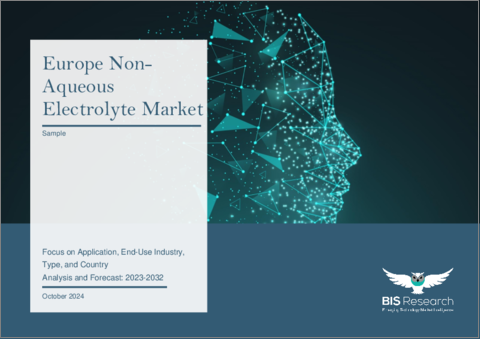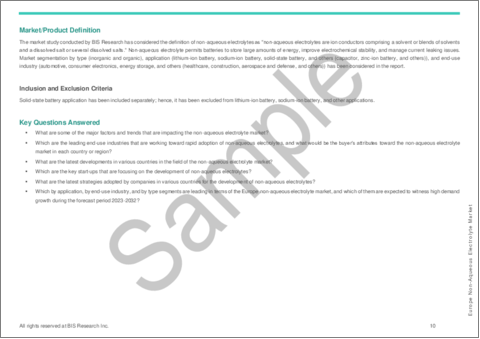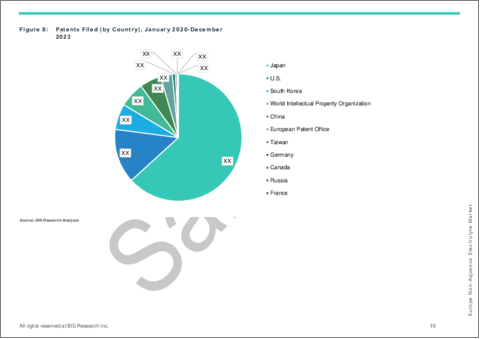|
|
市場調査レポート
商品コード
1570636
欧州の非水電解質市場:用途・エンドユーザー産業・タイプ・国別の分析・予測 (2023-2032年)Europe Non-Aqueous Electrolyte Market: Focus on Application, End-Use Industry, Type, and Country - Analysis and Forecast, 2023-2032 |
||||||
カスタマイズ可能
|
|||||||
| 欧州の非水電解質市場:用途・エンドユーザー産業・タイプ・国別の分析・予測 (2023-2032年) |
|
出版日: 2024年10月17日
発行: BIS Research
ページ情報: 英文 50 Pages
納期: 1~5営業日
|
全表示
- 概要
- 図表
- 目次
欧州の非水電解質の市場規模は、2023年の7億7,890万米ドルから、予測期間中は19.58%のCAGRで推移し、2032年には38億9,250万米ドルの規模に成長すると予測されています。
欧州における非水電解質の需要は、自動車、CE製品、エネルギー貯蔵などの主要産業が牽引し、増加すると予想されています。また、2023年から2032年にかけては、特にドイツやフランスのような欧州の先進経済圏で自動車分野での非水電解質使用の増加し、市場成長をさらに促進すると予測されています。リチウムイオン電池への依存度の高まりは、有機・無機両方の非水電解質の需要を押し上げるため、主要な促進要因となっています。一方で、原料価格の変動は、価格に敏感なこの市場に課題をもたらし、採用に影響を与える可能性があります。
| 主要市場統計 | |
|---|---|
| 予測期間 | 2023-2032年 |
| 2023年評価 | 7億7,890万米ドル |
| 2032年予測 | 38億9,250万米ドル |
| CAGR | 19.58% |
自動車、CE製品、エネルギー貯蔵を含む主要産業からの需要の高まりが、欧州の非水電解質市場を大きく成長させると予想されています。欧州が電化と持続可能性の向上に努める中、リチウムイオン電池の重要な構成要素である非水電解質の人気が高まっています。市場拡大を後押しすると予測される主な要因のひとつは、欧州全域、特にドイツ、フランス、英国などで電気自動車 (EV) の普及が進んでいることです。電気自動車 (EV) の製造には高度な電池技術が必要であり、非水電解質は電池の性能、寿命、安全性の向上に不可欠です。
この産業は、欧州における再生可能エネルギー分野の拡大と、効果的なエネルギー貯蔵ソリューションの必要性によってさらに支えられています。各国が二酸化炭素排出量の削減とグリーンエネルギーへのシフトを目指しているため、高性能エネルギー貯蔵システムのニーズが高まっており、それが非水電解質の需要を促進しています。
市場の分類
セグメンテーション1:用途別
- リチウムイオン電池
- ナトリウムイオン電池
- 固体電池
- その他
セグメンテーション2:エンドユーザー産業別
- 自動車
- CE製品
- エネルギー貯蔵
- その他
セグメンテーション3:タイプ別
- 有機
- 無機
セグメンテーション4:国別
- ドイツ
- フランス
- 英国
- その他
当レポートでは、欧州の非水電解質の市場を調査し、業界の動向、技術・特許の動向、法規制環境、市場成長促進要因・抑制要因、市場規模の推移・予測、各種区分・主要国別の詳細分析、競合情勢、主要企業のプロファイルなどをまとめています。
目次
エグゼクティブサマリー
範囲と定義
第1章 市場
- 動向:現在および将来の影響評価
- 動向分析:非水電解質市場
- EV向け非水電解質材料市場の拡大
- さまざまなエンドユーズにおける固体リチウム金属電池の需要の増加
- サプライチェーンの概要
- バリューチェーン分析
- マーケットマップ
- 研究開発レビュー
- 特許出願動向 (国・企業別)
- 主要な世界的出来事の影響分析
- 市場力学の概要
- 市場促進要因
- 市場の課題
- 市場機会
第2章 地域
- 地域別概要
- 欧州
- 地域概要
- 市場成長推進因子
- 市場課題
- 用途
- 製品
- ドイツ
- 用途
- 製品
- フランス
- 用途
- 製品
- 英国
- 用途
- 製品
- その他
- 用途
- 製品
第3章 市場:競合ベンチマーキング・企業プロファイル
- 競合情勢
第4章 調査手法
List of Figures
- Figure 1: Europe Non-Aqueous Electrolyte Market (by Application), 2022, 2026, and 2032
- Figure 2: Europe Non-Aqueous Electrolyte Market (by End-Use Industry), 2022, 2026, and 2032
- Figure 3: Europe Non-Aqueous Electrolyte Market (by Type), 2022, 2026, and 2032
- Figure 4: Non-Aqueous Electrolyte Market, Recent Developments
- Figure 5: Global Electric Vehicle Sales from 2020 to 2030
- Figure 6: Supply Chain Analysis for Non-Aqueous Electrolyte Market
- Figure 7: Patents Filed (by Company), January 2020-December 2023
- Figure 8: Patents Filed (by Country), January 2020-December 2023
- Figure 9: Impact Analysis of Market Navigating Factors, 2022-2032
- Figure 10: Strategic Initiatives, 2020-2023
- Figure 11: Share of Strategic Initiatives
- Figure 12: Data Triangulation
- Figure 13: Top-Down and Bottom-Up Approach
- Figure 14: Assumptions and Limitations
List of Tables
- Table 1: Market Snapshot
- Table 2: Non-Aqueous Electrolyte Market, Opportunities
- Table 3: Major Key Investor of Solid-State Batteries
- Table 4: Non-Aqueous Electrolyte Market (by Region), $Million, 2022-2032
- Table 5: Europe Non-Aqueous Electrolyte Market (by Application), $Million, 2022-2032
- Table 6: Europe Non-Aqueous Electrolyte Market (by End-Use Industry), $Million, 2022-2032
- Table 7: Europe Non-Aqueous Electrolyte Market (by Type), $Million, 2022-2032
- Table 8: Germany Non-Aqueous Electrolyte Market (by Application), $Million, 2022-2032
- Table 9: Germany Non-Aqueous Electrolyte Market (by End-Use Industry), $Million, 2022-2032
- Table 10: Germany Non-Aqueous Electrolyte Market (by Type), $Million, 2022-2032
- Table 11: France Non-Aqueous Electrolyte Market (by Application), $Million, 2022-2032
- Table 12: France Non-Aqueous Electrolyte Market (by End-Use Industry), $Million, 2022-2032
- Table 13: France Non-Aqueous Electrolyte Market (by Type), $Million, 2022-2032
- Table 14: U.K. Non-Aqueous Electrolyte Market (by Application), $Million, 2022-2032
- Table 15: U.K. Non-Aqueous Electrolyte Market (by End-Use Industry), $Million, 2022-2032
- Table 16: U.K. Non-Aqueous Electrolyte Market (by Type), $Million, 2022-2032
- Table 17: Rest-of-Europe Non-Aqueous Electrolyte Market (by Application), $Million, 2022-2032
- Table 18: Rest-of-Europe Non-Aqueous Electrolyte Market (by End-Use Industry), $Million, 2022-2032
- Table 19: Rest-of-Europe Non-Aqueous Electrolyte Market (by Type), $Million, 2022-2032
- Table 20: Market Share
Introduction to Europe Non-Aqueous Electrolyte Market
The Europe non-aqueous electrolyte market is projected to reach $3,892.5 million by 2032 from $778.9 million in 2023, growing at a CAGR of 19.58% during the forecast period 2023-2032. The demand for non-aqueous electrolytes in Europe is expected to rise, driven by key industries such as automotive, consumer electronics, and energy storage. Between 2023 and 2032, the increased use of non-aqueous electrolytes in the automotive sector, particularly in advanced European economies like Germany and France, is projected to further propel market growth. The growing reliance on lithium-ion batteries is a major driver, as it boosts demand for both organic and inorganic non-aqueous electrolytes. However, fluctuations in raw material prices may pose challenges in this price-sensitive market, potentially affecting adoption.
Market Introduction
| KEY MARKET STATISTICS | |
|---|---|
| Forecast Period | 2023 - 2032 |
| 2023 Evaluation | $778.9 Million |
| 2032 Forecast | $3,892.5 Million |
| CAGR | 19.58% |
The growing demand from major industries including automotive, consumer electronics, and energy storage is expected to propel the non-aqueous electrolyte market in Europe into significant growth. As Europe strives for increased electrification and sustainability, non-aqueous electrolytes-critical components of lithium-ion batteries-are becoming more and more popular. One of the main factors predicted to propel market expansion is the increasing use of electric cars (EVs) throughout Europe, especially in nations like Germany, France, and the UK. Advanced battery technologies are needed for the production of electric vehicles (EVs), and non-aqueous electrolytes are essential for improving the performance, lifespan, and safety of batteries.
The industry is further supported by the expanding renewable energy sector in Europe and the need for effective energy storage solutions. As countries aim to reduce carbon emissions and shift toward green energy, the need for high-performance energy storage systems is increasing, which in turn fuels the demand for non-aqueous electrolytes.
However, market problems persist, such as fluctuating raw material costs and the price-sensitive character of the European market. Notwithstanding these obstacles, the non-aqueous electrolyte market is expected to grow strongly throughout the projection period due to continuous advancements in electrolyte technology and the continent's dedication to electrification and green energy.
Market Segmentation
Segmentation 1: by Application
- Lithium-ion Battery
- Sodium-ion Battery
- Solid-State Battery
- Others
Segmentation 2: by End-Use Industry
- Automotive
- Consumer Electronics
- Energy Storage
- Others
Segmentation 3: by Type
- Organic
- Inorganic
Segmentation 4: by Country
- Germany
- France
- U.K.
- Rest-of-Europe
How can this report add value to an organization?
Product/Innovation Strategy: The product segment helps the reader understand the different non-aqueous electrolytes for various applications such as lithium-ion battery, sodium-ion battery, solid-state battery, and others. Moreover, the study provides the reader with a detailed understanding of the non-aqueous electrolyte market based on the end-use industries, including automotive, consumer electronics, energy storage, and others.
Growth/Marketing Strategy: The non-aqueous electrolyte market has seen major development by key players operating in the market, such as business expansions, partnerships, collaborations, mergers and acquisitions, and joint ventures. The favored strategy for the companies has been product developments, business expansions, and acquisitions to strengthen their position in the non-aqueous electrolyte market.
Table of Contents
Executive Summary
Scope and Definition
1 Market
- 1.1 Trends: Current and Future Impact Assessment
- 1.1.1 Trend Analysis: Non-Aqueous Electrolyte Market
- 1.1.2 Expanding Market of Non-Aqueous Electrolyte Materials for Electric Vehicles
- 1.1.3 Increasing Demand for Solid-State Lithium-Metal Batteries in Various End-Use Applications
- 1.2 Supply Chain Overview
- 1.2.1 Value Chain Analysis
- 1.2.2 Market Map
- 1.2.2.1 Non-Aqueous Electrolyte Market - Product (by Type)
- 1.2.2.1.1 Inorganic
- 1.2.2.1.2 Organic
- 1.2.2.1 Non-Aqueous Electrolyte Market - Product (by Type)
- 1.3 Research and Development Review
- 1.3.1 Patent Filing Trend (by Country, Company)
- 1.4 Impact Analysis for Key Global Events
- 1.5 Market Dynamics Overview
- 1.5.1 Market Drivers
- 1.5.1.1 Increasing Adoption of Electric Vehicles Worldwide
- 1.5.1.2 Growing Investments in Energy Storage Solutions
- 1.5.1.3 Rising Urbanization and Consumer Spending across the World
- 1.5.2 Market Challenges
- 1.5.2.1 High Cost of Non-Aqueous Electrolyte Materials
- 1.5.2.2 Regulatory and Safety Concerns
- 1.5.3 Market Opportunities
- 1.5.3.1 Increasing Investment in Renewable Energy Sources
- 1.5.3.2 Growing Concern for the Environment and Carbon Neutrality Targets
- 1.5.1 Market Drivers
2 Regions
- 2.1 Regional Summary
- 2.2 Europe
- 2.2.1 Regional Overview
- 2.2.2 Driving Factors for Market Growth
- 2.2.3 Factors Challenging the Market
- 2.2.4 Application
- 2.2.5 Product
- 2.2.6 Germany
- 2.2.7 Application
- 2.2.8 Product
- 2.2.9 France
- 2.2.10 Application
- 2.2.11 Product
- 2.2.12 U.K.
- 2.2.13 Application
- 2.2.14 Product
- 2.2.15 Rest-of-Europe
- 2.2.16 Application
- 2.2.17 Product
3 Markets - Competitive Benchmarking & Company Profiles
- 3.1 Competitive Landscape
4 Research Methodology
- 4.1 Data Sources
- 4.1.1 Primary Data Sources
- 4.1.2 Secondary Data Sources
- 4.1.3 Data Triangulation
- 4.2 Market Estimation and Forecast





